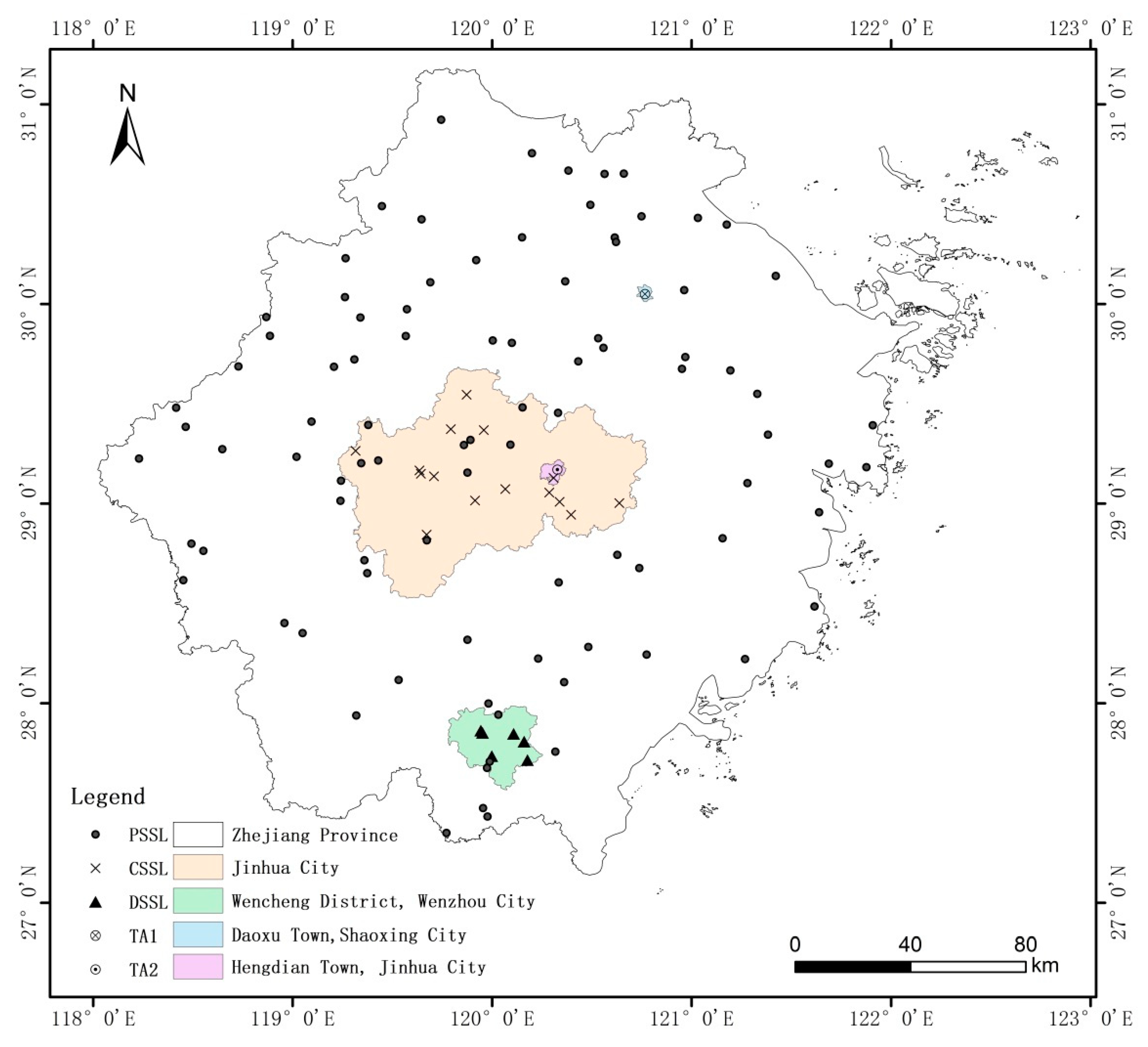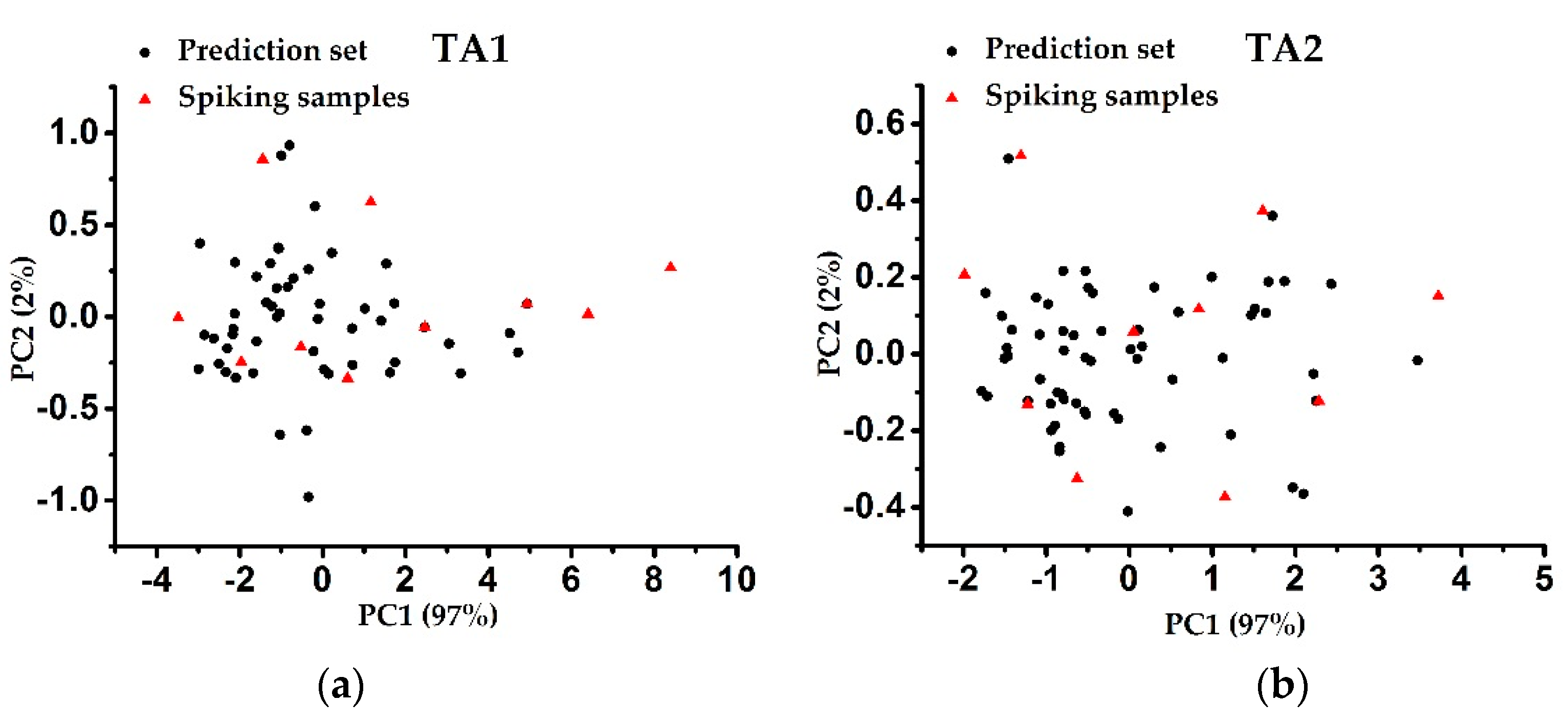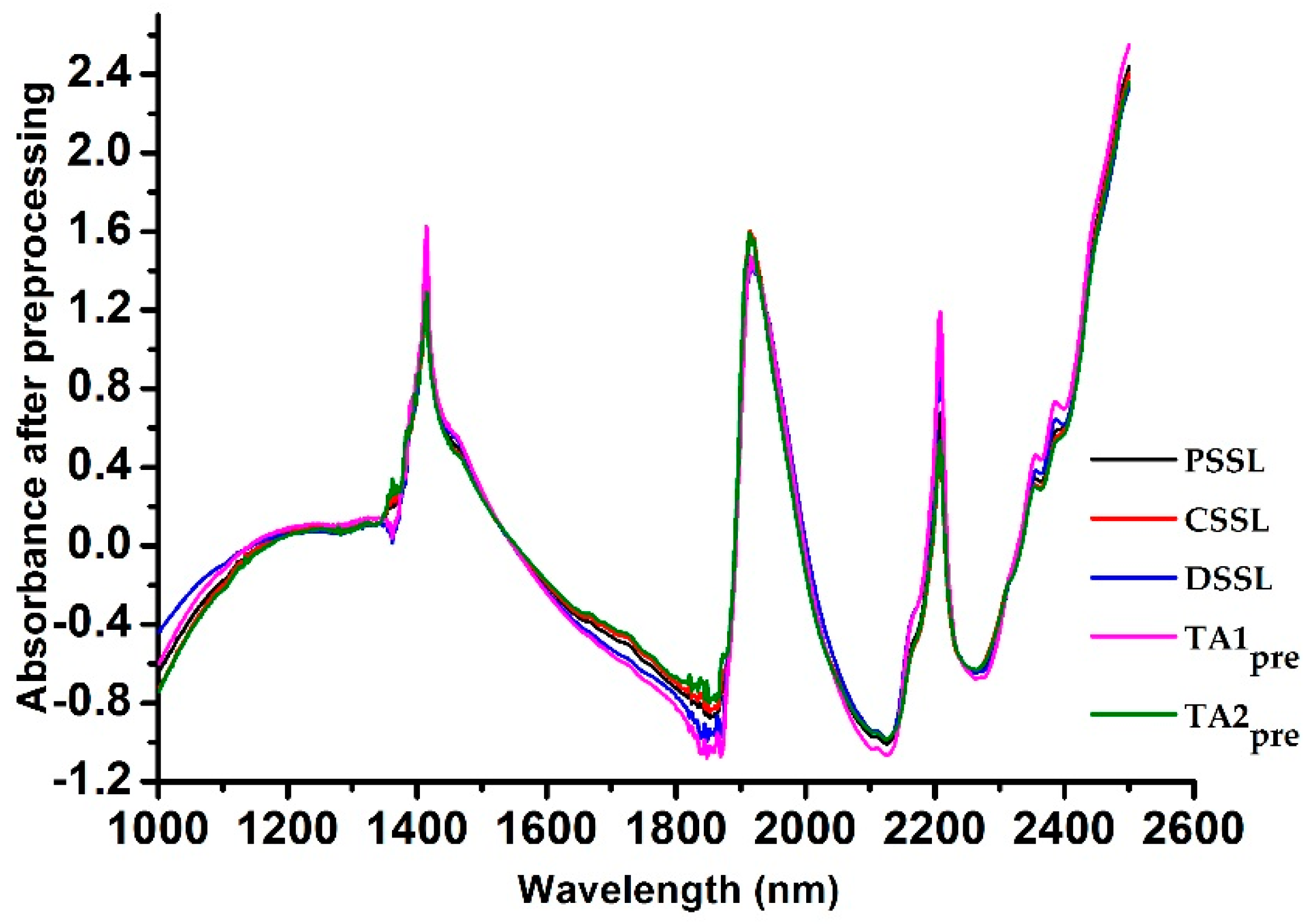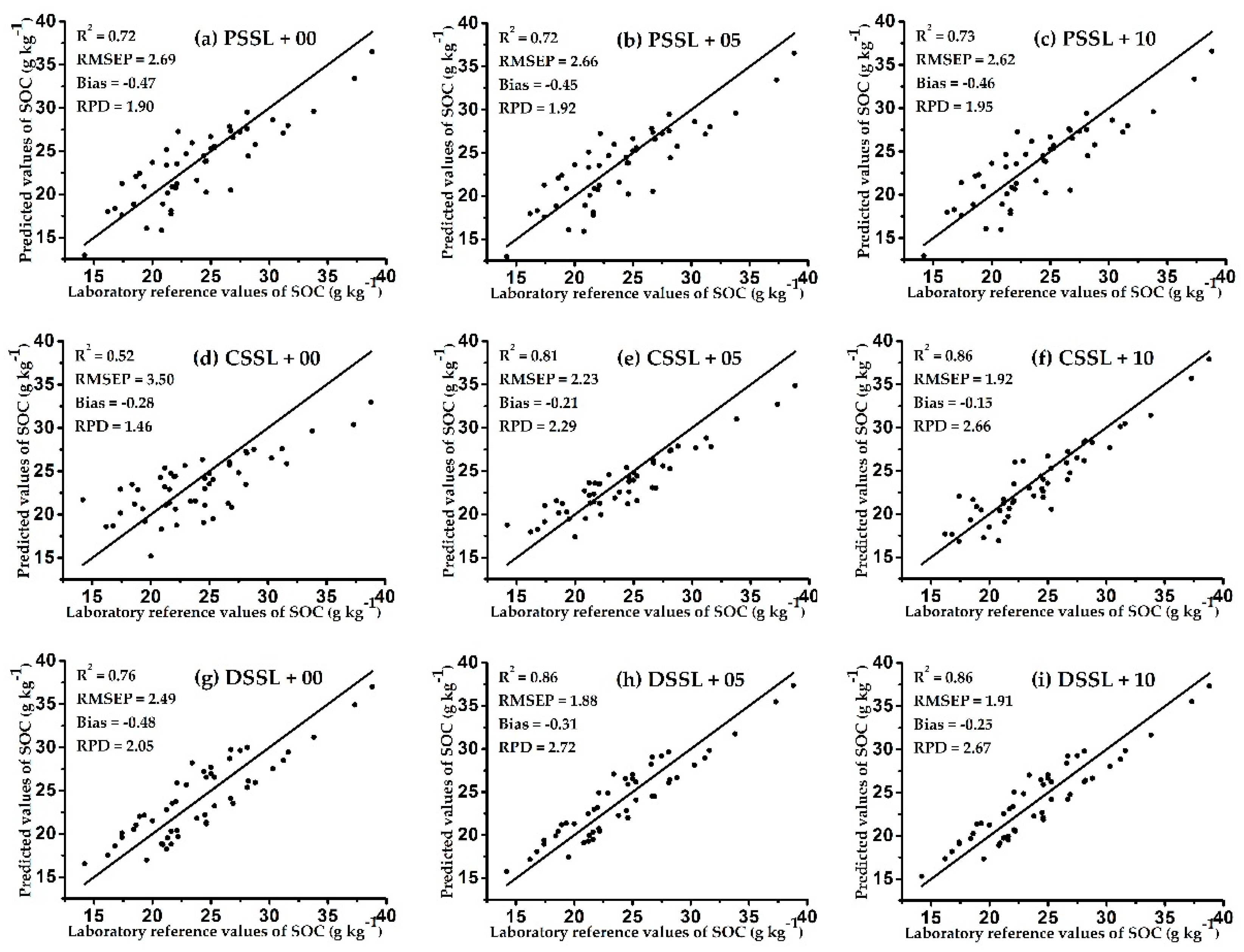3.3. Unspiked Models
Based on the three SSLs, each unspiked model (UM), PSSL-UM, CSSL-UM, and DSSL-UM, was established by PLS. Then, these models were used to predict the SOC contents of the samples in the two prediction sets, TA1
pre and TA2
pre. The statistical results for the prediction performances of the UMs are shown in
Table 5.
First, when the PSSL-UM established by the largest SSL was used to predict TA1
pre and TA2
pre, the RPD was 1.90 and 2.17, respectively. This may be because the large-scale PSSL covered the geographic range and soil types of TA2
pre, so a relatively good prediction effect was obtained. Meanwhile, when the soil type of TA1
pre was insufficient in the PSSL, the prediction effect was poor. These conclusions are similar to the results of Guerrero et al., indicating that large-scale soil libraries need to include the similar characteristics of soil samples in the target area to ensure a good prediction effect [
25].
Second, the best prediction effect (RPD = 2.36) was obtained when using the CSSL-UM to predict TA2
pre. Although the PSSL contained many more soil samples, CSSL may contain more samples similar to the soil characteristics in TA2
pre due to geographic location, so that the CSSL-UM achieved better prediction performance for TA2
pre. Other researchers found similar results. Zeng et al. reported that samples used in the calibration model were geographically close to the target area, so the modeled soils were likely to have similar characteristics and spectra to the target area samples [
26]. Furthermore, compared with a calibration model using all samples of a large-scale SSL, Liu et al. selected samples with similar spectral characteristics to the prediction set samples from the large-scale SSL for calibration modeling, and the ability to predict SOC content was significantly improved [
27]. However, when the CSSL neither covered the geographical range of TA1
pre nor contained enough samples of the same soil type, the prediction effect of the CSSL-UM on TA1
pre was very poor (RPD = 1.46).
Third, when using the DSSL-UM established by the smallest SSL to predict TA1
pre and TA2
pre, although the DSSL did not cover the geographic range of both target areas, the DSSL-UM had a moderate to good predictive ability (RPD = 2.05) for TA1
pre because the soil sample type in the DSSL was the same as TA1
pre. Araújo et al. found similar results; when the types and spectra of soil samples in the calibration set and the target area were similar, quantitative analysis of the target area could be carried out even if it was based on a small SSL [
28]. However, when some soil types in TA2
pre were missing in the DSSL, the prediction effect of the DSSL-UM on TA2
pre was poor (RPD = 1.83).
Comparing the performance of the UMs, we believe that it was a relatively stable method to use a large-scale SSL covering a wide geographic range and containing a full range of soil types to model, which can generally achieve better prediction results for target areas. However, among all the UMs, the CSSL-UM provided the best prediction results for TA2pre (R2 = 0.81, RMSEP = 2.81, bias = 0.18, RPD = 2.36), indicating that the predictive ability of the model could be improved when the SSL contained more soil samples similar to the soil spectrum in target areas. Therefore, in order to obtain a better prediction effect, we studied whether the predictive ability of the model could be improved by means of spiking.
3.4. Spiked Models
The KS algorithm was used to select 5 or 10 spiking samples from each target area to establish the spiked calibration model. Then, based on different SSLs and numbers of spiking samples, each spiked model (SM), PSSL-SM, CSSL-SM, and DSSL-SM, was established by PLS, and these models were used to predict the SOC content of the samples in prediction sets TA1
pre and TA2
pre. The statistical results of the prediction performances of the SMs are shown in
Table 6.
To formulate a more intuitive comparison before and after spiking, we needed to determine the differences between the prediction effects of spiking on the models established by the three SSLs containing different soil samples, soil types, and geographic ranges.
Figure 4 and
Figure 5 show scatter plots of the models’ predicted values for soil samples in prediction sets TA1
pre and TA2
pre, and the corresponding SOC laboratory reference value for each sample. Each row in the figures represents a model based on the same SSL. The left, middle, and right-hand columns show the prediction effect of the UMs, the SMs with 5 spiking samples from the target area, and the SMs with 10 spiking samples from the target area, respectively.
Three significant results are shown in
Figure 4 and
Figure 5. First, the prediction effect of each model was improved with the addition of spiking samples from the target areas, which indicates that the spiking method increased the predictive ability of the model. Other researchers also obtained similar results. Hong et al. found that adding spiking samples to the original model increased the accuracy of the prediction model [
29]. In addition, compared with the UMs, improvements in the predictive ability of SMs was inversely proportional to the scale of the SSL. This may be because the smaller the original SSL, the higher the corresponding proportion of spiking samples in the SSL. Therefore, the established prediction model was more consistent with the soil characteristics of the target area, thus obviously improving its predictive ability. Guerrero et al. found a similar phenomenon by comparing eight SSLs of different sizes; the improvement effect of spiking was weaker in the large-scale SSL models, but more obvious in the small-scale SSL models [
30].
Second, the method of spiking can solve the problem of poor prediction effect of the original model due to the lack of soil type samples in the target area. Comparing
Figure 4d–f, it can be seen that when the CSSL contained a low proportion of soil types in TA1, after adding 5 and 10 spiking samples of the target area, the prediction effect of the CSSL models on TA1
pre was continuously improved (the RPD increased from 1.46 to 2.29 and 2.66). In addition, comparing
Figure 5g–i shows that even when the DSSL lacked some soil type samples in TA2, after adding 5 and 10 spiking samples of the target area, the prediction effect of the DSSL models on TA2
pre was also continuously improved (the RPD increased from 1.83 to 2.77 and 3.16). However, when the original SSL already contained sufficient soil samples of similar characteristics to the target area, the predictive ability of the model was not significantly improved by spiking, and decreased due to saturation with the excessive number of spiking samples. For example, comparing
Figure 4h,i shows that when 10 spiking samples were added, the predictive ability of the DSSL model on TA1
pre was reduced compared with 5 spiking samples (the RPD decreased from 2.72 to 2.67). In addition, the predictive ability of the CSSL model on TA2
pre was also reduced when 10 spiking samples were added, compared with 5 spiking samples, as shown in
Figure 5e,f (the RPD decreased from 2.70 to 2.64). Seidel et al. found a similar result; when the number of spiking samples reached 15–20, the predictive ability of the model declined due to saturation [
31].
Third, the method of spiking caused the original SSL to not be affected by the geographic scope, so the model based on the small-scale SSL could be applied to the measurement of the target area outside the geographic scope of the SSL [
32]. For example, the geographic scope of the DSSL did not include TA1 and TA2, but after adding 5 and 10 spiking samples, respectively, the corresponding prediction models achieved good results (RPD > 2.5), as shown in
Figure 4h,i.
In my opinion, the number of spiking samples is firstly related to the method of selecting spiking samples. Guerrero et al. used the KS algorithm and selected 10% of the samples from the target area as the spiking samples according to the principle of uniform distribution of the principal component scores of the spectral data [
30]. Seidel et al. used the KS algorithm and selected 12.5% of the samples from the target area as the spiking samples according to the principle of maximum differentiation based on the Mahalanobis distance of spectral data [
31]. The results showed that these spiking samples had greatly improved the prediction accuracy of the model. Second, in order to make the spiking samples as representative of the soil characteristics of the target area as possible, the number of spiking samples should account for approximately 10% of the target set samples. In this work, for the small-scale SSL model DSSL-SM, the KS algorithm was used to select five spiking samples from two different target areas at a time (approximately 10% of the target set samples), the corresponding prediction models achieved good results (RPD > 2.5), as shown in
Figure 4h and
Figure 5h. Third, for the calibration model based on large-scale SSL, when the number of spiking samples is not enough to improve the prediction accuracy of the model, it is also considered to increase the weight of spiking samples to enhance their influence on the calibration model. Jiang et al. built the calibration model based on 608 soil samples, and selected 10 spiking samples from the target area. The results showed that the prediction accuracy of the model gradually improved as the weight of spiking samples was increased by 1, 5, and 10 times [
33].
Overall, for TA1
pre, the DSSL-SM with five spiking samples achieved the best prediction effect in all models, with an R
2 of 0.86, RMSEP of 1.92, bias of −0.15, and RPD of 2.72, as shown in
Figure 4h. For TA2
pre, the DSSL-SM with 10 spiking samples achieved the best prediction effect in all models, with an R
2 of 0.90, RMSEP of 2.10, bias of 0.21, and RPD of 3.16, as shown in
Figure 5i. In comparison, Castaldi et al. used 12,128 samples from the large-scale LUCAS soil library to predict the SOC of three target sites in Belgium and Luxembourg, and the best prediction accuracy of the model was an RPD of 2.54 and R
2 of 0.8 [
34]. This indicates that the prediction performance of the model based on the small-scale SSL can also be compared with that of the large-scale SSL model after adding a few (5–10) spiking samples.










